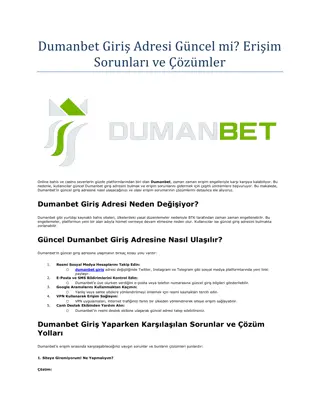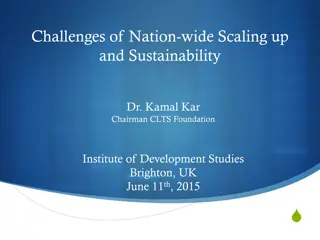
Microfinance Karnataka Summit 2023: Insights and Trends
Explore the key highlights from the Microfinance Karnataka Summit 2023, showcasing the growth of microfinance institutions in Karnataka, post-COVID trends, loan accounts, SHG loans, and more. Discover the positive and enabling environment, responsible finance behavior, and impressive growth over the last decade in the microfinance sector.
Download Presentation

Please find below an Image/Link to download the presentation.
The content on the website is provided AS IS for your information and personal use only. It may not be sold, licensed, or shared on other websites without obtaining consent from the author. If you encounter any issues during the download, it is possible that the publisher has removed the file from their server.
You are allowed to download the files provided on this website for personal or commercial use, subject to the condition that they are used lawfully. All files are the property of their respective owners.
The content on the website is provided AS IS for your information and personal use only. It may not be sold, licensed, or shared on other websites without obtaining consent from the author.
E N D
Presentation Transcript
Microfinance Karnataka Summit 2023 N Srinivasan Bengaluru 12 Sept 2023
Karnataka MF - Some features Cradle of banking and finance institutions Spawned many MFIs Positive and enabling environment Enterprise culture and credit discipline Active and informed government support Responsible finance behaviour of MFIs MF and SHG streams work in tandem, without hostility Changes in government do not impact public policy or approach Harmony in the field, despite competition Yes, AKMI has played a significant role
Post covid reversal of trends in loan accounts (lakhs) 120 101 99 100 75 74 80 69 68 65 62 62 60 52 42 40 20 0 2013 2014 2015 2016 2017 2018 2019 2020 2021 2022 2023
Microfinance and SHG loans in Karnataka Sharp increase in MF loans outstanding in FY 2023 35000 32270 30000 26191 25000 24524 21338 20420 20000 16520 15940 15000 14154 12645 11952 11883 11126 10879 10000 8149 8127 7475 5934 3916 5928 5000 4595 3294 MFI Loans Rs Crores SHG loans Rs crores 0 2013 2014 2015 2016 2017 2018 2019 2020 2021 2022 2023
Karnataka - MF loans as % of bank credit 5.0% 4.5% 5.0% 4.0% 4.9% 3.5% 4.7% 4.6% 4.5% 3.9% 3.0% 3.6% 2.5% 3.1% 2.7% 2.0% 2.3% 1.5% 1.0% 0.5% 0.0% 2013 2014 2015 2016 2017 2018 2019 2020 2021 2022 Impressive growth over last 10 years
Comparison across states Loan outstanding (Mar 23) Rs crores PAR 30+ days % (Mar 23) 46921 50000 46432 0.77 Uttar Pradesh 45000 40000 0.62 Karnataka 33898 32496 32271 35000 30000 2.01 W.Bengal 25000 20000 0.95 Bihar 15000 10000 1.69 Tamil Nadu 5000 0 Tamil Nadu Bihar W.Bengal Karnataka Uttar Pradesh 0 0.5 1 1.5 2 2.5 As Bihar and UP grow faster, Karnataka in fifth place Best risk profile across the top five states
Comparison across districts low income districts have relatively larger loan size Loan as % of income Average loan per capita Loan as % of income Top five Districts Bengaluru Urban Average loan per capita Bottom five Districts 13 Kalaburgi 30783 31 68067 23 Vijayapura 33051 29 Udupi Dakshin Kannada Uttara Kannada 67435 16 Yadagiri 33300 29 59852 29 Ballary 33380 19 48323 16 Bidar 33590 30 Chickmagalur Karnataka State 46799 19 Karnataka State 19 42194 42194
Portfolio quality % of PAR accounts % of PAR outstanding Name of district Name of district Mysuru 16.5 Mysuru 5.4 Chamarajanagara 15.7 Vijaypura 4.7 Bengaluru U 15.1 Chamarajanagara 4.6 Mandya 14.7 Bengaluru U 4.3 Udupi 13.4 Ramanagara 4.3 Mysuru, Bengaluru U and Chamarajanagara need attention
Clients voice Survey carried out by Shaisavi Project Consultants Ltd 2300+ customers in 7 districts covered Findings : 89% customers preferred MFIs over other lenders Quick loan sanction, facile processes and easy access key differentiators 90% of loans were applied for income generating purposes More than 60% customers reported positive impact on livelihoods/business More than 65% customers reported positive impact on family well being Women gain autonomy in running income generation activities Women gain better space in family decision making
Credit + activities MFIs very active beyond credit Focus on literacy, health, livelihoods,Women and children, skill development, Enterprise dev, disaster relief, (COVID relief), school and hospital infrastructure, Persons with disabilities, drinking water and Sanitation, environment protection Both CSR and mainstream support Extensive and intensive work on financial literacy and livelihood skills, enterprise building
Typical concerns High interest rates charged livelihood activities don t produce high returns Product structures unsuitable Not all livelihoods have monthly income flows Sustained customer development is not focused as customer attrition rate is high Group meetings heavy demand on customers time Digitalisation of cash txns can weaken relationships Competition erodes good practices Innovations are limited to technology adoption
Some reflections MFIs have done a power of good to vulnerable, low income people Customers come back in multiple cycles on account of the utility and functionality of MF credit (despite all criticism) Several customers improved their livelihoods and quality of life, through sustained access to MF Customers become financially competent as well as disciplined, both through training and practice
Moving ahead As we move forward we need to Innovate Diversify products Reduce interest rates to the extent feasible We need support of government and regulator for Lower cost of funds if farm and SHG loans can be subsidized, why not MFI loans If banks can give SHG loans at 9 to 10%, why not provide MFIs loans atleast at the same rates Allow MFIs to diversify loans to micro enterprises by lowering threshold of qualifying assets to 50% Allow MFIs also to issue PSLCs and participate as sellers of PSLCs




